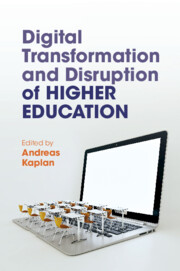Book contents
- Digital Transformation and Disruption of Higher Education
- Digital Transformation and Disruption of Higher Education
- Copyright page
- Contents
- Figures
- Tables
- Contributors
- Preface
- Chapter 1 Nothing Is Constant Except Change
- Part I (R)evolution of the Higher Education Sector
- Part II Changes in Teaching Formats
- Part III Changes in Teaching Content
- Part IV Networking and Social Activities
- Part V Certification and Diplomas
- Part VI Careers and Professionalisation
- Part VII Futuristic and Ultramodern Higher Education
- Chapter 27 Learning Analytics Enriched by Emotions
- Chapter 28 Personal Analytics in the Science of Learning
- Chapter 29 The AI Economy and Higher Education
- Part VIII Higher Education in Motion
- Editor’s Biography
- Index
- References
Chapter 28 - Personal Analytics in the Science of Learning
from Part VII - Futuristic and Ultramodern Higher Education
Published online by Cambridge University Press: 09 June 2022
- Digital Transformation and Disruption of Higher Education
- Digital Transformation and Disruption of Higher Education
- Copyright page
- Contents
- Figures
- Tables
- Contributors
- Preface
- Chapter 1 Nothing Is Constant Except Change
- Part I (R)evolution of the Higher Education Sector
- Part II Changes in Teaching Formats
- Part III Changes in Teaching Content
- Part IV Networking and Social Activities
- Part V Certification and Diplomas
- Part VI Careers and Professionalisation
- Part VII Futuristic and Ultramodern Higher Education
- Chapter 27 Learning Analytics Enriched by Emotions
- Chapter 28 Personal Analytics in the Science of Learning
- Chapter 29 The AI Economy and Higher Education
- Part VIII Higher Education in Motion
- Editor’s Biography
- Index
- References
Summary
Universities, as with other social institutions, have had to adapt to the pressures of change driven by the digital revolution. Given that education as a discipline is rooted in the very practice of transformation, it is not surprising it could play a core role in promoting and developing this new terrain; at least that was the vision in the 1990’s. Twenty years on, it appears higher education may well have missed some opportunities. The recognition of student-centred learning, while upheld in rhetoric, has failed to be realised in practice. Much of the digital influence in higher education has concentrated on technologies for content delivery to support the principle that learning is the result of teaching. In this chapter, we offer an alternative view of learning as a personal endeavour fuelled by inquiry rather than institutional compliance. We argue that emerging wearable technologies offer a new frontier into the science of learning, in ways that were previously unimaginable. We begin by addressing our rationale and some of the historical tensions in this space. This is followed by two scenarios where wearable devices were deployed by students, eager to gain a deeper understanding of the impact of stress and sleep on their academic endeavours. We believe this work illustrates the importance of physiological markers for a more student-centred approach in the practice of learning.
- Type
- Chapter
- Information
- Digital Transformation and Disruption of Higher Education , pp. 377 - 390Publisher: Cambridge University PressPrint publication year: 2022

